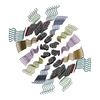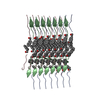+ Open data
Open data
- Basic information
Basic information
| Entry |  | |||||||||
|---|---|---|---|---|---|---|---|---|---|---|
| Title | Cryo-EM of helical fibers formed by (NAP)FFGPQYQP | |||||||||
 Map data Map data | full map | |||||||||
 Sample Sample |
| |||||||||
 Keywords Keywords | peptide fiber / helical polymer / protein fibril | |||||||||
| Biological species | synthetic construct (others) | |||||||||
| Method | helical reconstruction / cryo EM / Resolution: 2.87 Å | |||||||||
 Authors Authors | Zia A / Qiao Y / Xu B / Wang F | |||||||||
| Funding support |  United States, 2 items United States, 2 items
| |||||||||
 Citation Citation |  Journal: Angew Chem Int Ed Engl / Year: 2025 Journal: Angew Chem Int Ed Engl / Year: 2025Title: Intrinsically Disordered Peptide Nanofibers from a Structured Motif Within Proteins. Authors: Yuchen Qiao / Ayisha Zia / Adrianna Shy / Grace Wu / Matthew Chu / Zhiyu Liu / Fengbin Wang / Bing Xu /  Abstract: Intrinsically disordered regions (IDRs) are ubiquitous in proteins, orchestrating complex cellular signaling through higher-order protein assemblies. However, the properties and functions of ...Intrinsically disordered regions (IDRs) are ubiquitous in proteins, orchestrating complex cellular signaling through higher-order protein assemblies. However, the properties and functions of intrinsically disordered peptide (IDP) assemblies are largely underexplored. This work unveiled a facile strategy for engineering IDP assemblies. We demonstrate that conjugating a structured motif derived from a protein's phosphorylation site to a self-assembling tripeptide unexpectedly yields self-assembled nanofibers with intrinsic disorder. Specifically, by using a glycine linker to attach a pentapeptide derived from a phosphorylation site within a random coil region of SRC kinase to the C-terminus of a widely used self-assembling enabler, we generated a phosphorylated octapeptide. The octapeptide exhibits cell compatibility and forms a hydrogel upon dephosphorylation of the phosphooctapeptide. Cryo-electron microscopy (cryo-EM) structural analysis of the nanofibers reveals that the peptides adopt two types of helical arrangements but exhibit intrinsic disorder at the periphery of the nanofibers. The hydrogels exhibit decreased protein adsorption with increasing peptide concentration. This study represents the first instance of a structured random coil within a protein transitioning into an intrinsically disordered state within self-assembled peptide nanofibers, expanding the pool of peptide sequences for IDPs and providing valuable insights for the engineering of peptide nanofibers with intrinsic disorder for the development of cell-compatible biomaterials. | |||||||||
| History |
|
- Structure visualization
Structure visualization
| Supplemental images |
|---|
- Downloads & links
Downloads & links
-EMDB archive
| Map data |  emd_48237.map.gz emd_48237.map.gz | 97.9 MB |  EMDB map data format EMDB map data format | |
|---|---|---|---|---|
| Header (meta data) |  emd-48237-v30.xml emd-48237-v30.xml emd-48237.xml emd-48237.xml | 15.4 KB 15.4 KB | Display Display |  EMDB header EMDB header |
| Images |  emd_48237.png emd_48237.png | 95.3 KB | ||
| Filedesc metadata |  emd-48237.cif.gz emd-48237.cif.gz | 4.7 KB | ||
| Others |  emd_48237_half_map_1.map.gz emd_48237_half_map_1.map.gz emd_48237_half_map_2.map.gz emd_48237_half_map_2.map.gz | 102.4 MB 104.8 MB | ||
| Archive directory |  http://ftp.pdbj.org/pub/emdb/structures/EMD-48237 http://ftp.pdbj.org/pub/emdb/structures/EMD-48237 ftp://ftp.pdbj.org/pub/emdb/structures/EMD-48237 ftp://ftp.pdbj.org/pub/emdb/structures/EMD-48237 | HTTPS FTP |
-Validation report
| Summary document |  emd_48237_validation.pdf.gz emd_48237_validation.pdf.gz | 748.4 KB | Display |  EMDB validaton report EMDB validaton report |
|---|---|---|---|---|
| Full document |  emd_48237_full_validation.pdf.gz emd_48237_full_validation.pdf.gz | 748 KB | Display | |
| Data in XML |  emd_48237_validation.xml.gz emd_48237_validation.xml.gz | 13.8 KB | Display | |
| Data in CIF |  emd_48237_validation.cif.gz emd_48237_validation.cif.gz | 16.6 KB | Display | |
| Arichive directory |  https://ftp.pdbj.org/pub/emdb/validation_reports/EMD-48237 https://ftp.pdbj.org/pub/emdb/validation_reports/EMD-48237 ftp://ftp.pdbj.org/pub/emdb/validation_reports/EMD-48237 ftp://ftp.pdbj.org/pub/emdb/validation_reports/EMD-48237 | HTTPS FTP |
-Related structure data
- Links
Links
| EMDB pages |  EMDB (EBI/PDBe) / EMDB (EBI/PDBe) /  EMDataResource EMDataResource |
|---|
- Map
Map
| File |  Download / File: emd_48237.map.gz / Format: CCP4 / Size: 125 MB / Type: IMAGE STORED AS FLOATING POINT NUMBER (4 BYTES) Download / File: emd_48237.map.gz / Format: CCP4 / Size: 125 MB / Type: IMAGE STORED AS FLOATING POINT NUMBER (4 BYTES) | ||||||||||||||||||||||||||||||||||||
|---|---|---|---|---|---|---|---|---|---|---|---|---|---|---|---|---|---|---|---|---|---|---|---|---|---|---|---|---|---|---|---|---|---|---|---|---|---|
| Annotation | full map | ||||||||||||||||||||||||||||||||||||
| Projections & slices | Image control
Images are generated by Spider. | ||||||||||||||||||||||||||||||||||||
| Voxel size | X=Y=Z: 1.12 Å | ||||||||||||||||||||||||||||||||||||
| Density |
| ||||||||||||||||||||||||||||||||||||
| Symmetry | Space group: 1 | ||||||||||||||||||||||||||||||||||||
| Details | EMDB XML:
|
-Supplemental data
-Half map: half map A
| File | emd_48237_half_map_1.map | ||||||||||||
|---|---|---|---|---|---|---|---|---|---|---|---|---|---|
| Annotation | half map A | ||||||||||||
| Projections & Slices |
| ||||||||||||
| Density Histograms |
-Half map: half map B
| File | emd_48237_half_map_2.map | ||||||||||||
|---|---|---|---|---|---|---|---|---|---|---|---|---|---|
| Annotation | half map B | ||||||||||||
| Projections & Slices |
| ||||||||||||
| Density Histograms |
- Sample components
Sample components
-Entire : (I7L)FFGPQYQP
| Entire | Name: (I7L)FFGPQYQP |
|---|---|
| Components |
|
-Supramolecule #1: (I7L)FFGPQYQP
| Supramolecule | Name: (I7L)FFGPQYQP / type: complex / ID: 1 / Parent: 0 / Macromolecule list: all |
|---|---|
| Source (natural) | Organism: synthetic construct (others) / Synthetically produced: Yes |
-Macromolecule #1: (I7L)FFGPQYQP
| Macromolecule | Name: (I7L)FFGPQYQP / type: protein_or_peptide / ID: 1 / Number of copies: 7 / Enantiomer: LEVO |
|---|---|
| Source (natural) | Organism: synthetic construct (others) |
| Molecular weight | Theoretical: 1.151267 KDa |
| Sequence | String: (I7L)FFGPQYQP |
-Experimental details
-Structure determination
| Method | cryo EM |
|---|---|
 Processing Processing | helical reconstruction |
| Aggregation state | filament |
- Sample preparation
Sample preparation
| Buffer | pH: 7 |
|---|---|
| Vitrification | Cryogen name: ETHANE |
- Electron microscopy
Electron microscopy
| Microscope | TFS KRIOS |
|---|---|
| Image recording | Film or detector model: GATAN K3 (6k x 4k) / Average electron dose: 50.0 e/Å2 |
| Electron beam | Acceleration voltage: 300 kV / Electron source:  FIELD EMISSION GUN FIELD EMISSION GUN |
| Electron optics | Illumination mode: FLOOD BEAM / Imaging mode: BRIGHT FIELD / Nominal defocus max: 2.0 µm / Nominal defocus min: 1.0 µm |
| Experimental equipment |  Model: Titan Krios / Image courtesy: FEI Company |
- Image processing
Image processing
| Final reconstruction | Applied symmetry - Helical parameters - Δz: 5.04 Å Applied symmetry - Helical parameters - Δ&Phi: -2.55 ° Applied symmetry - Helical parameters - Axial symmetry: C2 (2 fold cyclic) Resolution.type: BY AUTHOR / Resolution: 2.87 Å / Resolution method: FSC 0.143 CUT-OFF / Number images used: 858964 |
|---|---|
| CTF correction | Type: PHASE FLIPPING AND AMPLITUDE CORRECTION |
| Startup model | Type of model: NONE |
| Final angle assignment | Type: NOT APPLICABLE |
 Movie
Movie Controller
Controller







 Z (Sec.)
Z (Sec.) Y (Row.)
Y (Row.) X (Col.)
X (Col.)




































